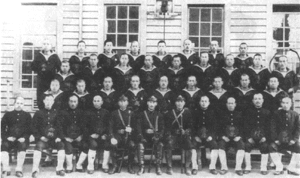
The invasion of Tulagi, on May 3 and May 4, 1942, was part of Operation Mo, the Empire of Japan's strategy in the South Pacific and South West Pacific Area in 1942. The plan called for Imperial Japanese Navy troops to capture Tulagi and nearby islands in the Solomon Islands Protectorate. The occupation of Tulagi by the Japanese was intended to cover the flank of Japanese forces that were advancing on Port Moresby in New Guinea as well as to provide a base for Japanese forces to threaten and interdict the supply and communication routes between the United States and Australia and New Zealand. Without the means to capably resist the Japanese offensive in the Solomons, the British Resident Commissioner of the Solomon Islands protectorate and the few Australian troops assigned to defend Tulagi evacuated the island just before the Japanese forces arrived on May 3. The next day, however, a U.S. aircraft carrier task force en route to resist the Japanese forces advancing on Port Moresby (that resulted in the Battle of the Coral Sea) struck the Japanese Tulagi landing force in an air attack, destroying or damaging several of the Japanese ships and aircraft involved in the landing operation. Nevertheless, the Japanese troops successfully occupied Tulagi and began the construction of a small naval base. Over the next several months, the Japanese established a naval refueling, communications, and seaplane base on Tulagi and the nearby islets of Gavutu and Tanambogo and, in July 1942, began to build a large airfield on nearby Guadalcanal. The Japanese activities on Tulagi and Guadalcanal were observed by Allied reconnaissance aircraft, as well as by Australian coastwatcher personnel stationed in the area. (Full article...)